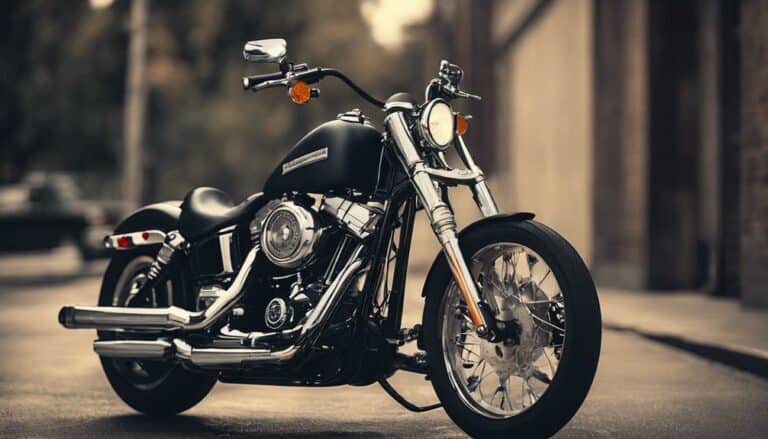When you rev up a Harley Davidson motorcycle, the purr of the engine is music to your ears.
But have you ever wondered why Harley Davidson opts for belt drives instead of chain drives?
The choice might surprise you, considering the benefits it brings to the table.
The efficiency and reliability of belt drives play a significant role in Harley Davidson's performance, but there's more to the story than meets the eye.
Key Takeaways
- Quieter operation and enhanced durability make belt drive ideal for Harley Davidson.
- Improved performance and cost-effectiveness in power transfer highlight the advantages of belt drive.
- Evolution towards advanced drive technology showcases the reliability and benefits of belt drive.
- Future trends indicate advancements in durability, efficiency, and increased adoption in motorcycles.
Benefits of Belt Drive for Harley Davidson
Harley Davidson significantly benefits from the utilization of belt drive systems due to their quieter operation, lower maintenance requirements, enhanced durability, improved performance, and cost-effectiveness in transferring power to the rear wheel.
The adoption of belt drives by Harley-Davidson in the 1980s, starting with models like the FXB Sturgis and later Dyna models, marked a pivotal moment in the brand's history. This transition brought about a notable improvement in performance and reliability of the big V-Twin engines, making the riding experience more enjoyable and efficient for Harley enthusiasts.
The Softail and Touring models, which incorporated belt drives in the mid-1980s, showcased the advantages of this technology, demonstrating how it could enhance the overall performance and longevity of Harley-Davidson motorcycles.
Evolution of Belt Drive in Harley
During the transition period from chain to belt drives in the mid-1980s, Harley-Davidson strategically introduced specific limited models to showcase the benefits of this modern drive system. The FXB Sturgis, introduced in 1980, marked the first Harley-Davidson motorcycle to feature a belt drive, setting the stage for a shift towards this advanced technology.
Subsequently, Shovelhead models, starting in 1984, began incorporating belt drives, with the FLHP being the final Shovelhead engine equipped with a belt drive in 1985. This gradual integration of belt drives into Harley-Davidson motorcycles represented a significant leap forward in the industry, aiming to improve maintenance practices and offer riders a more reliable and efficient drive system.
Performance Advantages of Belt Drive
Integrating belt drives into Harley-Davidson motorcycles revolutionized the industry by significantly enhancing performance. This was achieved through smoother and quieter operation, increased power transfer efficiency, and reduced maintenance requirements.
Belt drives offer a distinct advantage over traditional chain drives by providing a seamless and noise-free riding experience. The absence of metal-on-metal contact reduces vibration and noise, resulting in a smoother ride that enhances overall comfort and enjoyment.
Additionally, belt drives require less maintenance and have a longer lifespan, making them a cost-effective choice for riders looking to minimize upkeep and maximize time on the road. The enhanced power transfer efficiency of belt drives ensures that more power generated by the engine reaches the rear wheel, translating into improved acceleration and performance on the road.
Maintenance Considerations for Belt Drive
For optimal performance and longevity of the belt drive system in your motorcycle, regular inspection for premature wear every 5,000 miles is recommended. This maintenance practice ensures that your belt drive operates smoothly and efficiently.
Here are some key maintenance considerations for your belt drive:
- Inspect for Premature Wear: Look for signs of wear such as cracks, fraying, or stretching.
- Check Tension: Ensure the belt is properly tensioned to prevent slippage and premature wear.
- Keep It Clean: Regularly clean the belt to prevent debris buildup that could cause damage.
- Monitor Oil Back: Check for any oil leaks that could contaminate the belt and reduce its lifespan.
Future Trends in Belt Drive Technology
To explore the future trends in belt drive technology, it's essential to consider how manufacturers may leverage advancements in durability and maintenance efficiency to enhance the performance of motorcycle systems. While chains have traditionally dominated the motorcycle industry due to their versatility and adaptability, belts are gaining traction for their cost-effectiveness, longevity, and power transfer efficiency.
Despite facing challenges in quick final-drive ratio changes in racing environments due to fixed sizes, belts offer significant advantages that make them a viable option for future motorcycle technology.
In the coming years, advancements in belt materials and manufacturing processes are likely to improve their durability, making them more suitable for a wider range of riding conditions. Enhancements in maintenance procedures and technologies will also contribute to the increased adoption of belts in motorcycles, reducing the overall upkeep required for these systems.
While chains may still hold a place in certain applications, the future of belt drive technology appears promising, providing an efficient and reliable power transfer solution for motorcycle enthusiasts seeking liberation on the road.
Conclusion
In conclusion, the utilization of belt drives by Harley Davidson is a strategic choice that combines durability, efficiency, and performance.
The evolution of belt drive technology has revolutionized the riding experience, providing a smooth and quiet operation while ensuring longevity and low maintenance.
As the industry continues to innovate, the future of belt drive technology holds promise for even greater advancements in power transmission, solidifying its position as a key component in Harley Davidson motorcycles.


The info. I was after. Very well conveyed. Thank you !